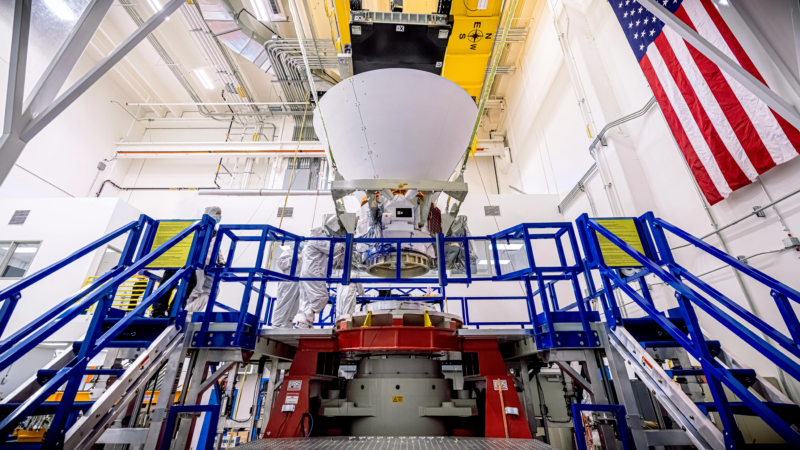Searching the entire sky for the secrets to our universe
As soon as the end of February, NASA and the Jet Propulsion Laboratory will launch a new telescope into orbit around the Earth called SPHEREx. Its goal is to examine nothing less than the essential ingredients of life in our galaxy and the origin of the universe itself.
SPHEREx will join the ranks of other space telescopes, filling in a crucial gap by detecting infrared light with wavelengths too long to see with the naked eye. It’s an important addition because no single instrument can fully perceive the universe and its contents.
The new telescope’s infrared detectors have to be kept super cold, so the instrument is housed inside three concentric cones atop a set of mirrors that protect it from the sun’s energy and the spacecraft’s own heat. The whole thing looks like a giant funnel.
“It weighs a little less than a grand piano and uses about 270, 300 watts of power — less than a refrigerator,” said Beth Fabinsky, SPHEREx’s deputy project manager, at a press conference in late January.
Other telescopes like Hubble and the James Webb Space Telescope can see celestial objects in exquisite detail but have a fairly limited field of view. SPHEREx, by contrast, “has a very large field of view and we see the entire sky twice each year,” said Fabinsky.
Such a vast view of the sky is intended to allow astronomers to answer some of the biggest questions of all — like how we got here.
“I expect the unexpected to come out of the data for this mission,” said James Fanson, the project manager of SPHEREx.

Everything in no time at all
A mere billionth of a trillionth of a trillionth of a second after the Big Bang, our universe expanded dramatically — a trillion-trillion fold.
“And that expansion expanded tiny fluctuations smaller than an atom to enormous cosmological scales that we see today traced out by galaxies,” said Jamie Bock, SPHEREx’s principal investor based at CalTech, who also spoke at the press conference.
Astronomers agree on this general picture of what happened in the earliest moments of the universe, but they still don’t know what propelled the expansion or why it happened in the first place. The goal of the new telescope is to help answer those questions by mapping the position of several hundred million galaxies across the entire sky.
“We won’t see the Big Bang itself,” said Bock, “but we’ll see the aftermath from it and learn about the beginning of the universe that way. We can use [infrared] to determine the distance to galaxies to build up that three-dimensional map.”
A few hundred million years after the Big Bang came a period known as the cosmic dawn when the first stars and galaxies were born. Star formation peaked some five billion years later and it’s been on a slow decline ever since, according to Bock. But astronomers worry they may not be accounting for all the light inside galaxies that may be too tiny, too diffuse, or too far away for other telescopes to have detected.
“SPHEREx is going to address this subject in a novel way,” said Bock. “It’s going to look at the total glow produced by all galaxies. And by looking this way, we can see if we’ve missed any sources of light.” This could allow Bock and others to find galaxies that, until now, have been hidden.
Finding the fingerprints of life
Infrared can also be used to detect the unique fingerprints of particular molecules in the universe, including the basic components of life — water and organic materials frozen in the ices of interstellar dust clouds where stars are born.
“This is a topic of some interest for us on Earth,” said Bock, “because the water we see here on Earth’s oceans — astronomers believe that initially came from these interstellar reservoirs of ices.”
All the data the telescope collects will be freely accessible to scientists, including those not involved in the development of SPHEREx like Stephanie Jarmak, a planetary scientist at the Harvard and Smithsonian Center for Astrophysics.
“The way it’s designed,” she says, “it’s going to be really useful to a whole host of different science questions and opportunities.”
For Jarmak, that includes examining objects within our own solar system, like asteroids. She says that SPHEREx’s infrared detectors will help her identify particular asteroids of interest, which she can then look at in more detail using other telescopes like James Webb.
“It’s always exciting to have a new suite of observations available,” says Jarmak.
Fabinsky is also excited. “If Hamlet is right and there are more things in heaven and Earth than are dreamt of in our philosophies, SPHEREx may capture that in its all-sky spectral survey,” she said at the close of her press conference remarks.
Transcript:
AYESHA RASCOE, HOST:
As soon as the end of this month, NASA and the Jet Propulsion Laboratory could launch a new telescope into orbit around the Earth called SPHEREx. Its goal is to examine nothing less than the components of life in our galaxy and the origin of the universe itself. Here’s science reporter Ari Daniel.
ARI DANIEL: A mere billionth of a trillionth of a trillionth of a second after the big bang, our universe expanded dramatically.
JAMIE BOCK: And that expansion expanded tiny fluctuations smaller than an atom to enormous cosmological scales that we see today traced out by galaxies.
DANIEL: Jamie Bock is the principal investigator of SPHEREx and spoke at a press conference in late January. Astronomers agree on this general picture of what happened in the earliest moments of the universe, but they still don’t know what propelled that expansion or why it happened in the first place. The goal of the new telescope is to help answer those questions by mapping the position of several hundred million galaxies across the entire sky.
BOCK: We won’t see the big bang itself, but we’ll see the aftermath from it and learn about the beginning of the universe that way.
DANIEL: No single instrument can see the universe and its contents fully, but SPHEREx will join the ranks of other space telescopes, filling in a crucial gap by detecting infrared light with wavelengths too long to see with the naked eye.
BOCK: We can use that to determine the distance to galaxies to build up that three-dimensional map.
DANIEL: Now, a few hundred million years after the big bang came a period called the Cosmic Dawn when the first stars and galaxies were born. Star formation peaked some 5 billion years later, and it’s been on a slow decline ever since. But astronomers worry they may not be accounting for all the light out there inside galaxies that may be too tiny, too diffuse or too far away for other telescopes to have detected.
BOCK: SPHEREx is going to address this subject in a novel way. It’s going to look at the total glow produced by all galaxies. And by looking this way, we can see if we’ve missed any sources of light.
DANIEL: Allowing Bock and others to find galaxies that, until now, have been hidden. Infrared can also be used to detect the unique fingerprints of particular molecules in the universe, including the ingredients of life. Water and organic materials frozen in the ices of interstellar dust clouds where stars are formed.
BOCK: This is a topic of some interest for us on Earth because the water we see here on Earth’s oceans, astronomers believe that initially came from these interstellar reservoirs of ices.
DANIEL: SPHEREx’s infrared detectors have to be kept super cold, so the instruments housed inside three concentric cones atop a set of mirrors that protect it from sunlight and the spacecraft’s own heat. The whole thing looks like a giant funnel.
BETH FABINSKY: It weighs a little less than a grand piano and uses about 270, 300 watts of power, less than a refrigerator.
DANIEL: Beth Fabinsky is SPHEREx’s deputy project manager, who also spoke at the press conference. She says that telescopes like Hubble or James Webb can see celestial objects in exquisite detail but have a fairly limited field of view. SPHEREx, by contrast…
FABINSKY: Our telescope has a very large field of view, and we see the entire sky twice each year.
DANIEL: All the data the telescope collects will be freely available to scientists like Stephanie Jarmak, a planetary scientist at the Harvard & Smithsonian Center for Astrophysics.
STEPHANIE JARMAK: The way it’s designed, it’s going to be really useful to a whole host of different science questions and opportunities.
DANIEL: For Jarmak, that includes examining objects within our own solar system like asteroids.
JARMAK: It’s always exciting to have, you know, a new suite of observations available.
DANIEL: Fabinsky is also excited.
FABINSKY: If Hamlet is right, and there are more things in heaven and Earth than are dreamt of in our philosophies, SPHEREx may capture that in its all-sky spectral survey.
DANIEL: For NPR News, I’m Ari Daniel.
Auburn tabs USF’s Alex Golesh as its next coach, replacing Hugh Freeze on the Plains
The 41-year-old Golesh, who was born in Russia and moved to the United State at age 7, is signing a six-year contract that averages more than $7 million annually to replace Hugh Freeze. Freeze was fired in early November after failing to fix Auburn’s offensive issues in three seasons on the Plains.
Alabama Power seeks to delay rate hike for new gas plant amid outcry
The state’s largest utility has proposed delaying the rate increase from its purchase of a $622 million natural gas plant until 2028.
Former U.S. Sen. Doug Jones announces run for Alabama governor
Jones announced his campaign Monday afternoon, hours after filing campaign paperwork with the Secretary of State's Office. His gubernatorial bid could set up a rematch with U.S. Sen. Tommy Tuberville, the Republican who defeated Jones in 2020 and is now running for governor.
Scorching Saturdays: The rising heat threat inside football stadiums
Excessive heat and more frequent medical incidents in Southern college football stadiums could be a warning sign for universities across the country.
The Gulf States Newsroom is hiring an Audio Editor
The Gulf States Newsroom is hiring an Audio Editor to join our award-winning team covering important regional stories across Mississippi, Alabama and Louisiana.
Judge orders new Alabama Senate map after ruling found racial gerrymandering
U.S. District Judge Anna Manasco, appointed by President Donald Trump during his first term, issued the ruling Monday putting a new court-selected map in place for the 2026 and 2030 elections.









